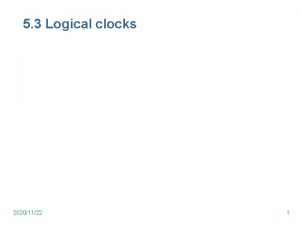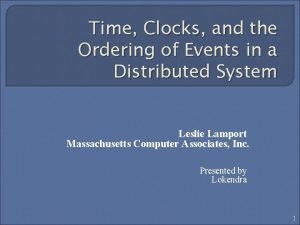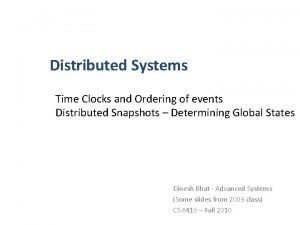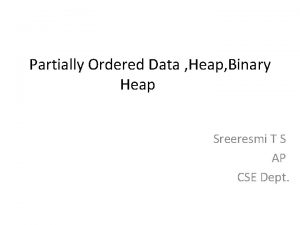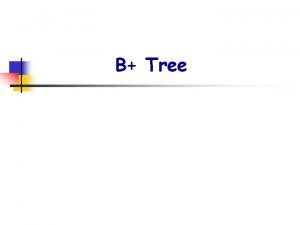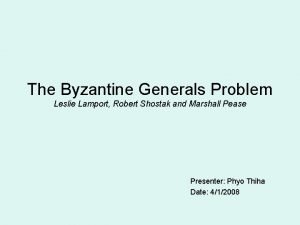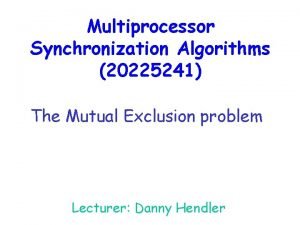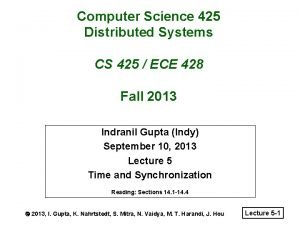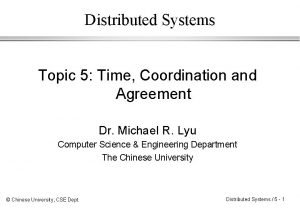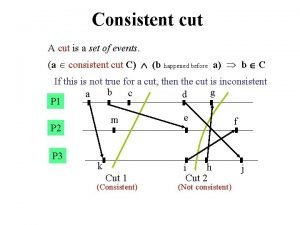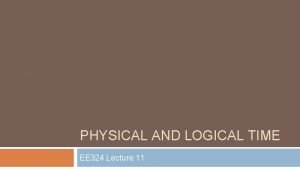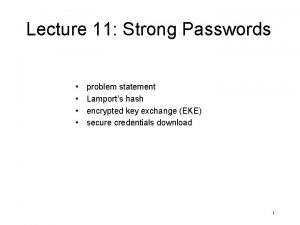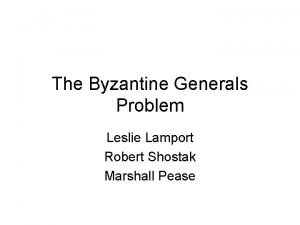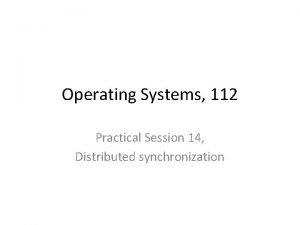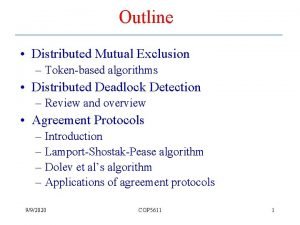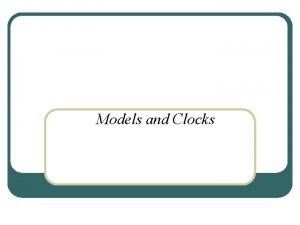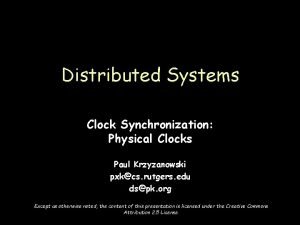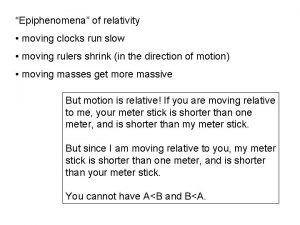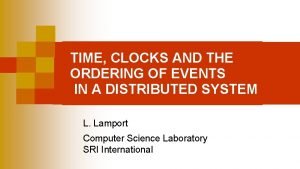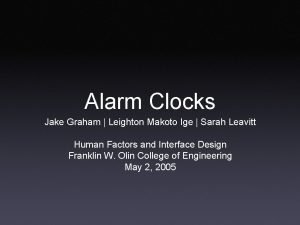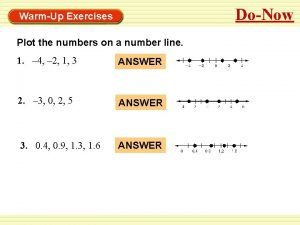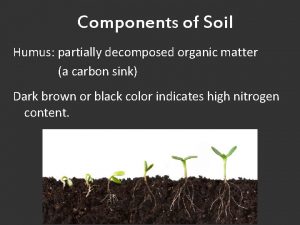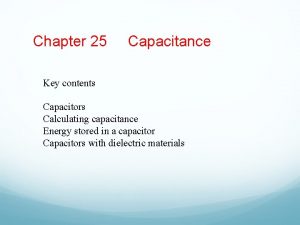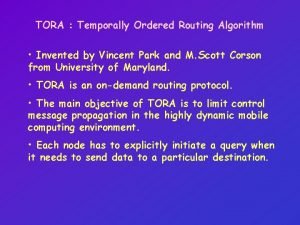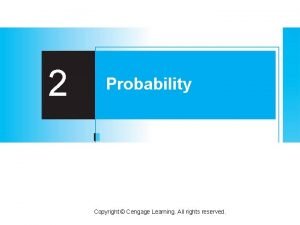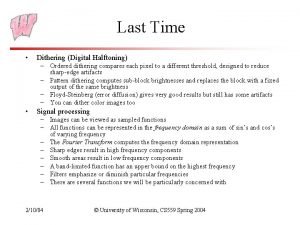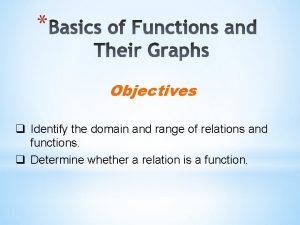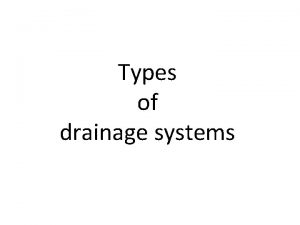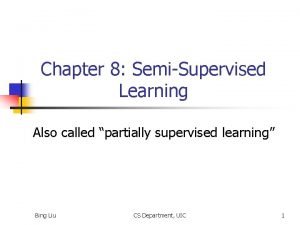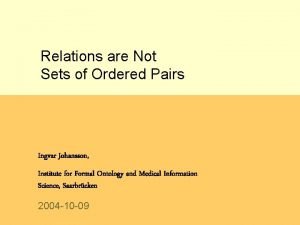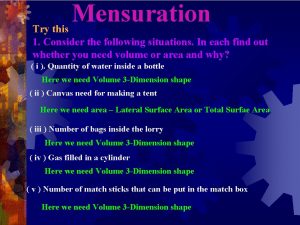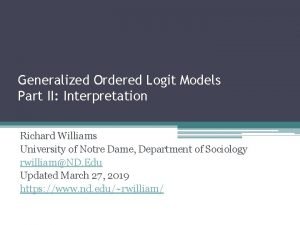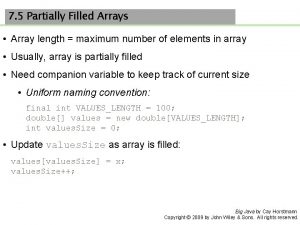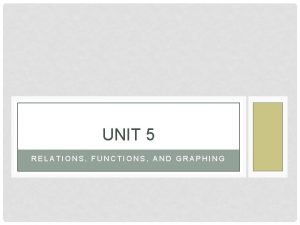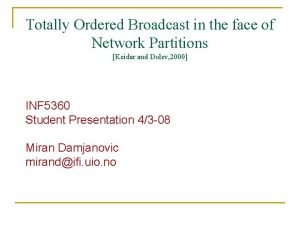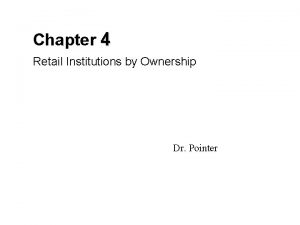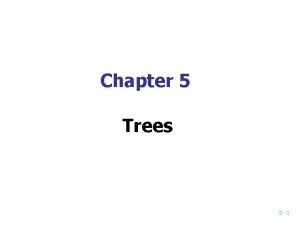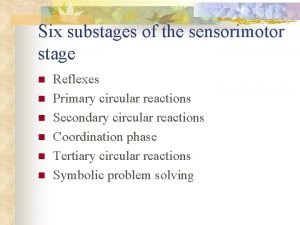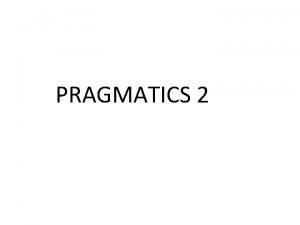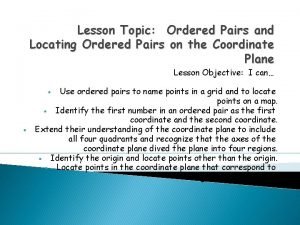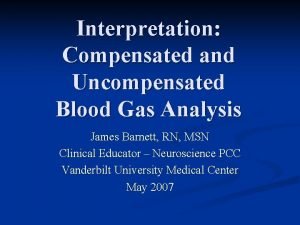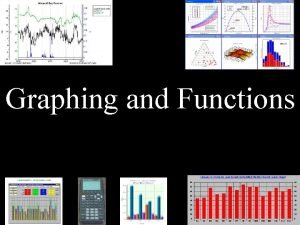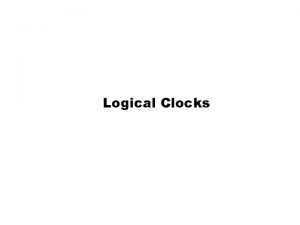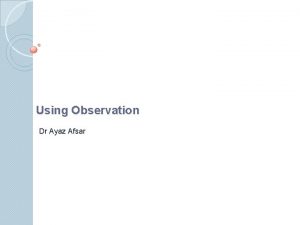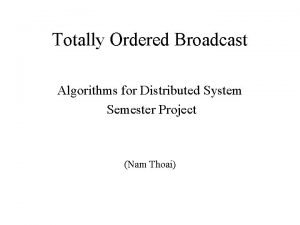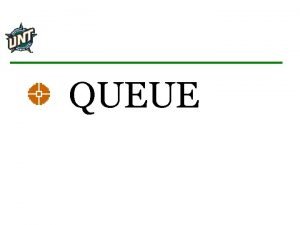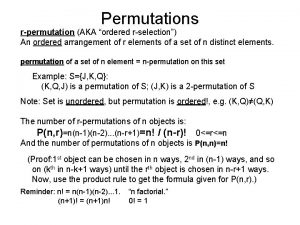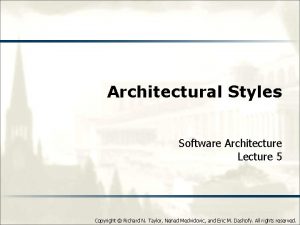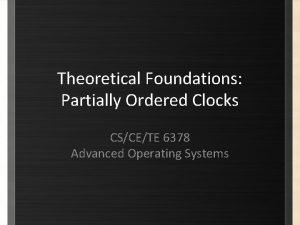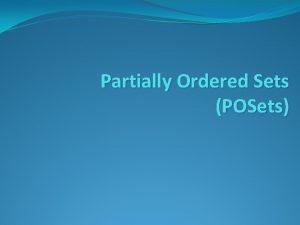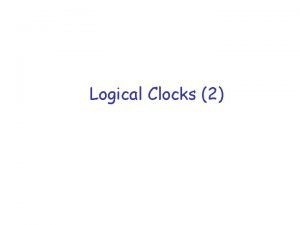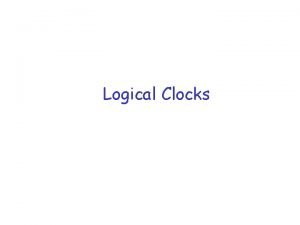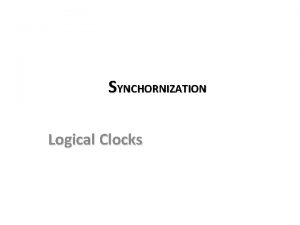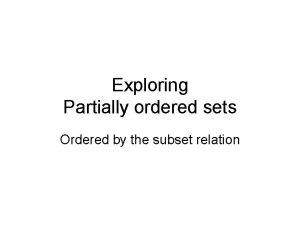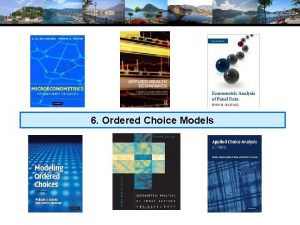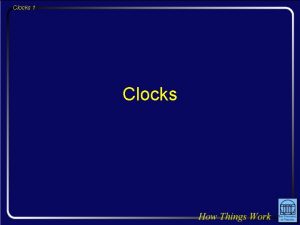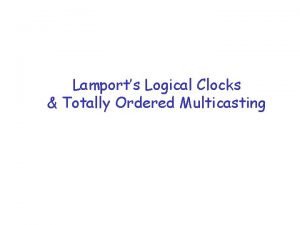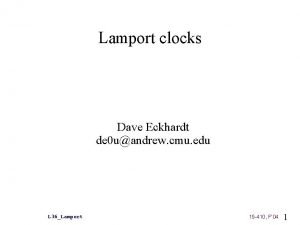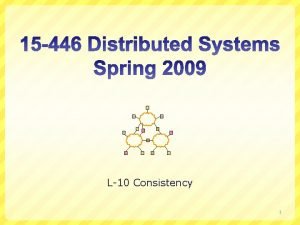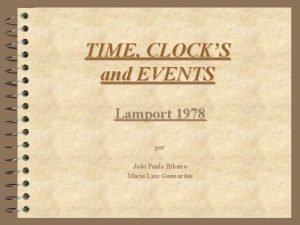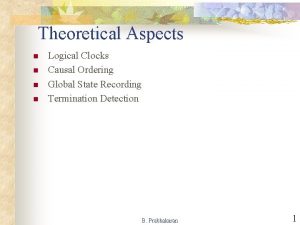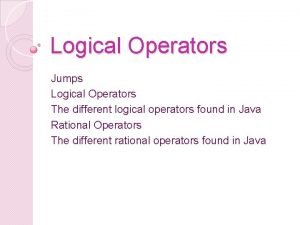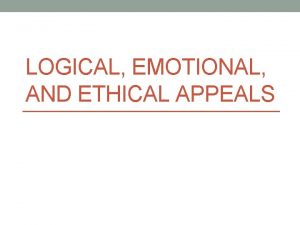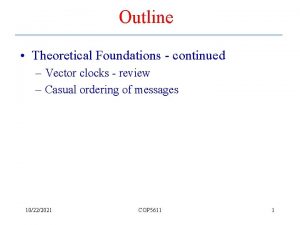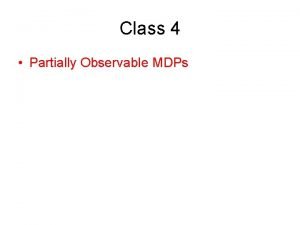Theoretical Foundations Clocks Logical clocks Lamport Partially ordered





![Vector Clock Exercise [0 0 0] P Q p 1 = [1 0 0] Vector Clock Exercise [0 0 0] P Q p 1 = [1 0 0]](https://slidetodoc.com/presentation_image/1fe86232ee3b3ed68a7d5a14cebb20c9/image-6.jpg)



















![BSS Protocol Rules ▸ Rule 1 Before sending message m, process i increments Ci[i] BSS Protocol Rules ▸ Rule 1 Before sending message m, process i increments Ci[i]](https://slidetodoc.com/presentation_image/1fe86232ee3b3ed68a7d5a14cebb20c9/image-26.jpg)
![BSS Protocol Example ▸ Rule 1: i increments Ci[i] and timestamps m [0 0 BSS Protocol Example ▸ Rule 1: i increments Ci[i] and timestamps m [0 0](https://slidetodoc.com/presentation_image/1fe86232ee3b3ed68a7d5a14cebb20c9/image-27.jpg)
![BSS Protocol Example ▸ Rule 1: i increments Ci[i] and timestamps m [0 0 BSS Protocol Example ▸ Rule 1: i increments Ci[i] and timestamps m [0 0](https://slidetodoc.com/presentation_image/1fe86232ee3b3ed68a7d5a14cebb20c9/image-28.jpg)




![BSS Protocol Example ▸ Rule 2: Deliver the message [0 0 0] [0 1 BSS Protocol Example ▸ Rule 2: Deliver the message [0 0 0] [0 1](https://slidetodoc.com/presentation_image/1fe86232ee3b3ed68a7d5a14cebb20c9/image-33.jpg)



![BSS Protocol Example ▸ Rule 1: i increments Ci[i] and timestamps m [0 1 BSS Protocol Example ▸ Rule 1: i increments Ci[i] and timestamps m [0 1](https://slidetodoc.com/presentation_image/1fe86232ee3b3ed68a7d5a14cebb20c9/image-37.jpg)
![BSS Protocol Example ▸ Rule 1: i increments Ci[i] and timestamps m [1 1 BSS Protocol Example ▸ Rule 1: i increments Ci[i] and timestamps m [1 1](https://slidetodoc.com/presentation_image/1fe86232ee3b3ed68a7d5a14cebb20c9/image-38.jpg)



![BSS Protocol Example ▸ Rule 2: Deliver the message [1 1 0] [0 1 BSS Protocol Example ▸ Rule 2: Deliver the message [1 1 0] [0 1](https://slidetodoc.com/presentation_image/1fe86232ee3b3ed68a7d5a14cebb20c9/image-42.jpg)




![BSS Protocol Example ▸ Rule 2: Delay delivering the message [1 1 0] R BSS Protocol Example ▸ Rule 2: Delay delivering the message [1 1 0] R](https://slidetodoc.com/presentation_image/1fe86232ee3b3ed68a7d5a14cebb20c9/image-47.jpg)



![BSS Protocol Example ▸ Rule 2: Deliver the message [1 1 0] R 1 BSS Protocol Example ▸ Rule 2: Deliver the message [1 1 0] R 1](https://slidetodoc.com/presentation_image/1fe86232ee3b3ed68a7d5a14cebb20c9/image-51.jpg)





![BSS Protocol Example ▸ Rule 2: Deliver the message [1 1 0] R 1 BSS Protocol Example ▸ Rule 2: Deliver the message [1 1 0] R 1](https://slidetodoc.com/presentation_image/1fe86232ee3b3ed68a7d5a14cebb20c9/image-57.jpg)


![BSS Protocol Example 2 ▸ Rule 1: i increments Ci[i] and timestamps m [0 BSS Protocol Example 2 ▸ Rule 1: i increments Ci[i] and timestamps m [0](https://slidetodoc.com/presentation_image/1fe86232ee3b3ed68a7d5a14cebb20c9/image-60.jpg)
![BSS Protocol Example 2 ▸ Rule 1: i increments Ci[i] and timestamps m [1 BSS Protocol Example 2 ▸ Rule 1: i increments Ci[i] and timestamps m [1](https://slidetodoc.com/presentation_image/1fe86232ee3b3ed68a7d5a14cebb20c9/image-61.jpg)



![BSS Protocol Example 2 ▸ Rule 2: Deliver the message [1 0 0] P BSS Protocol Example 2 ▸ Rule 2: Deliver the message [1 0 0] P](https://slidetodoc.com/presentation_image/1fe86232ee3b3ed68a7d5a14cebb20c9/image-65.jpg)


![BSS Protocol Example 2 ▸ Rule 1: i increments Ci[i] and timestamps m [1 BSS Protocol Example 2 ▸ Rule 1: i increments Ci[i] and timestamps m [1](https://slidetodoc.com/presentation_image/1fe86232ee3b3ed68a7d5a14cebb20c9/image-68.jpg)
![BSS Protocol Example 2 ▸ Rule 1: i increments Ci[i] and timestamps m [2 BSS Protocol Example 2 ▸ Rule 1: i increments Ci[i] and timestamps m [2](https://slidetodoc.com/presentation_image/1fe86232ee3b3ed68a7d5a14cebb20c9/image-69.jpg)

![BSS Protocol Example 2 ▸ Rule 2: Delay delivering the message [2 0 0] BSS Protocol Example 2 ▸ Rule 2: Delay delivering the message [2 0 0]](https://slidetodoc.com/presentation_image/1fe86232ee3b3ed68a7d5a14cebb20c9/image-71.jpg)
![BSS Protocol Example 2 ▸ Rule 1: i increments Ci[i] and timestamps m [2 BSS Protocol Example 2 ▸ Rule 1: i increments Ci[i] and timestamps m [2](https://slidetodoc.com/presentation_image/1fe86232ee3b3ed68a7d5a14cebb20c9/image-72.jpg)
![BSS Protocol Example 2 ▸ Rule 1: i increments Ci[i] and timestamps m [2 BSS Protocol Example 2 ▸ Rule 1: i increments Ci[i] and timestamps m [2](https://slidetodoc.com/presentation_image/1fe86232ee3b3ed68a7d5a14cebb20c9/image-73.jpg)



![BSS Protocol Example 2 ▸ Rule 2: Deliver the message [2 0 0] P BSS Protocol Example 2 ▸ Rule 2: Deliver the message [2 0 0] P](https://slidetodoc.com/presentation_image/1fe86232ee3b3ed68a7d5a14cebb20c9/image-77.jpg)





![BSS Protocol Example 2 ▸ Rule 2: Deliver the message [2 0 0] P BSS Protocol Example 2 ▸ Rule 2: Deliver the message [2 0 0] P](https://slidetodoc.com/presentation_image/1fe86232ee3b3ed68a7d5a14cebb20c9/image-83.jpg)





![BSS Protocol Example 2 ▸ Rule 2: Deliver the message [2 0 0] P BSS Protocol Example 2 ▸ Rule 2: Deliver the message [2 0 0] P](https://slidetodoc.com/presentation_image/1fe86232ee3b3ed68a7d5a14cebb20c9/image-89.jpg)


![BSS Protocol Example 2 [2 0 0] P [1 0 0] [2 1 0] BSS Protocol Example 2 [2 0 0] P [1 0 0] [2 1 0]](https://slidetodoc.com/presentation_image/1fe86232ee3b3ed68a7d5a14cebb20c9/image-92.jpg)
![BSS Protocol Example 2 ▸ Rule 2: Deliver the message [2 0 0] P BSS Protocol Example 2 ▸ Rule 2: Deliver the message [2 0 0] P](https://slidetodoc.com/presentation_image/1fe86232ee3b3ed68a7d5a14cebb20c9/image-93.jpg)

![BSS Protocol Example 2 ▸ Rule 2: Deliver the message [2 1 0] P BSS Protocol Example 2 ▸ Rule 2: Deliver the message [2 1 0] P](https://slidetodoc.com/presentation_image/1fe86232ee3b3ed68a7d5a14cebb20c9/image-95.jpg)






![Proof of BSS Liveness: Counterexample 1 ▸ If k = i then tm[k] will Proof of BSS Liveness: Counterexample 1 ▸ If k = i then tm[k] will](https://slidetodoc.com/presentation_image/1fe86232ee3b3ed68a7d5a14cebb20c9/image-102.jpg)
![Proof of BSS Liveness: Counterexample 2 ▸ If k ≠ i then tm[k] will Proof of BSS Liveness: Counterexample 2 ▸ If k ≠ i then tm[k] will](https://slidetodoc.com/presentation_image/1fe86232ee3b3ed68a7d5a14cebb20c9/image-103.jpg)


- Slides: 105

Theoretical Foundations ▸ Clocks ▹ Logical clocks (Lamport) ▹ Partially ordered clocks (Fidge) ▸ Causally ordered message delivery ▹ Broadcast-based (Birman et al. ) ▹ Unicast-based (Raynal, Schiper & Toueg) ▸ System states ▹ Global snapshots (Chandy & Lamport) ▹ Termination detection (Huang) Theoretical Foundations 1

“Happened Before” Conditions ▸ Sequential Behavior: If events e and f occur in the same process p, and f occurs after e, then e → f. ▸ Process Creation: If event e and process q occur in the same process p, and event f occurs in q, and q begins after e, then e → f. ▸ Process Termination: If event e and process q occur in the same process p, and event f occurs in q, and e occurs after q terminates, then f → e. ▸ Synchronous Message-Passing: If event e is a synchronous send, and event f is the corresponding receive, and there is an event g such that e → g, then f → g. If there is an event h such that h → e, then h → f. ▸ Asynchronous Message-Passing: If event e is an asynchronous send, and event f is the corresponding receive, then e → f. ▸ Transitivity: If e → f and f → g, then e → g. Theoretical Foundations > Partially Ordered Clocks > Happened Before Relation 2

Implementation Rules ▸ A. Initialization: When the main process m begins, its clock is initialized to Cm = { }. ▸ B. Ticking: Whenever a process i performs an event, it increments Ci(i). ▸ C. Monotonically Increasing Counters: No counter is ever decreased. ▸ D. Process Creation: Whenever a process j is created by process i, Cj is set equal to Ci. ▸ E. Process Termination: Whenever a process j terminates, the clock of the parent process i is set to Ci = max(Ci, Cj). ▸ F. Synchronous Events: During a synchronous event, all processes involved maximize their local clocks (i. e. , ∀x: [j…r] Cx = max(Cj, …, Cr) ). ▸ G. Sending: Whenever a process i sends a message, it timestamps it the current value of Ci. ▸ H. Receiving: Upon receiving a message m, the clock of the receiving process i is set to Ci = max(Ci, Cm). ▸ I. Timestamping: Events are timestamped with the current clock value. Theoretical Foundations > Partially Ordered Clocks > Implementation Rules 3

Comparison Property ▸ Given two timestamps tei and tfj, event ei happened before event fj iff tfj has knowledge of process i as recent as the execution of ei but not vice versa ei fj (tei(i) ≤ tfj(i)) ∧ (tei(j) < tfj(j)) Theoretical Foundations > Partially Ordered Clocks > Comparison Property 4

Optimization: Vector Clocks ▸ Assume a static number of processes ▸ Use an array of counters instead of pairs ▸ Pros: ▹ Provide an upper bound on storage requirements for clock variables ▹ Clock variables are easier to read and manipulate ▸ Cons: ▹ The upper bound on storage requirements is also the lower bound Theoretical Foundations > Partially Ordered Clocks > Vector Clocks 5
![Vector Clock Exercise 0 0 0 P Q p 1 1 0 0 Vector Clock Exercise [0 0 0] P Q p 1 = [1 0 0]](https://slidetodoc.com/presentation_image/1fe86232ee3b3ed68a7d5a14cebb20c9/image-6.jpg)
Vector Clock Exercise [0 0 0] P Q p 1 = [1 0 0] Tm = [1 0 0] p 2 = [2 1 0] Tm = [0 1 0] q 1 = [0 1 0] q 2 = [1 2 0] Tm = [0 1 0] r 1 = [0 0 1] p 3 = [3 1 0] p 4 = [4 5 0] Tm = [1 5 0] q 4 = [1 4 0] q 6 = [1 6 0] q 7 = [1 7 2] q 3 = [1 3 0] T = [1 4 0] q 5 = [1 5 0] m Tm = [0 0 2] r 2 = [0 0 2] r 3 = [1 4 3] R ▸ Vector = [P Q R] ▸ r 2 q 4 ? No, (2 ≤/ 0) ^ (0 < 4) r 4 = [1 4 4] [0 0 0] Theoretical Foundations > Partially Ordered Clocks > Vector Clocks 6

Theoretical Foundations ▸ Clocks ▹ Logical clocks (Lamport) ▹ Partially ordered clocks (Fidge) ▸ Causally ordered message delivery ▹ Broadcast-based (Birman et al. ) ▹ Unicast-based (Raynal, Schiper & Toueg) ▸ System states ▹ Global snapshots (Chandy & Lamport) ▹ Termination detection (Huang) Theoretical Foundations 7

Theoretical Foundations: Broadcast-based Causal Delivery CS/CE/TE 6378 Advanced Operating Systems

Ordering of Message Delivery ▸ Example: redundant, distributed database X Y R 1 create(R 1) Z Theoretical Foundations > Causal Delivery 9

Ordering of Message Delivery ▸ Example: redundant, distributed database R 1 X Y R 1 create(R 1) Z Theoretical Foundations > Causal Delivery 10

Ordering of Message Delivery ▸ Example: redundant, distributed database R 1 X R 1 update(R 1) Y R 1 create(R 1) Z Theoretical Foundations > Causal Delivery 11

Ordering of Message Delivery ▸ Example: redundant, distributed database R 1 X R 1 update(R 1) Y R 1 create(R 1) Z ? Theoretical Foundations > Causal Delivery 12

Ordering of Message Delivery ▸ Example: redundant, distributed database R 1 X R 1 update(R 1) Y R 1 Problem create(R 1) R 1 create(R 1) Z ? R 1 Theoretical Foundations > Causal Delivery 13

Basics of Message Delivery ▸ sendp(m) ▹ Transmission of message m by process p to a set of destinations denoted destinations(m) ▸ receiveq(m) ▹ Reception of message m by process q ▹ sendp(m) receiveq(m) ▸ deliverq(m) ▹ Delivery of message m to process q ▹ receiveq(m) deliverq(m) Theoretical Foundations > Causal Delivery 14

Causal Delivery ▸ Causal Delivery: ▹ If sendi(w) sendj(m), and q ∈ destinations(w) and q ∈ destinations(m), then deliverq(w) deliverq(m) ▸ What’s an example of a causal delivery protocol? ▹ Transmission Control Protocol (TCP) Theoretical Foundations > Causal Delivery 15

Causal Delivery Example ▸ Violation of casual delivery? Yes R 1 X R 1 update(R 1) Y R 1 create(R 1) Z ? R 1 Theoretical Foundations > Causal Delivery 16

Causal Delivery Example ▸ send. Y(create) send. X(update)? Yes R 1 X R 1 update(R 1) Y R 1 create(R 1) Z ? R 1 Theoretical Foundations > Causal Delivery 17

Causal Delivery Example ▸ Z ∈ both destinations()? Yes R 1 X R 1 update(R 1) Y R 1 create(R 1) Z ? R 1 Theoretical Foundations > Causal Delivery 18

Causal Delivery Example ▸ deliver. Z(create) deliver. Z(update)? No R 1 X R 1 update(R 1) Y R 1 create(R 1) Z ? R 1 Theoretical Foundations > Causal Delivery 19

Causal Delivery Example ▸ Violation of casual delivery? No R 1 X Y R 1 update(R 1) Z R 1 Theoretical Foundations > Causal Delivery 20

Causal Delivery Example ▸ send. Y(update) send. X(update)? No R 1 X Y R 1 update(R 1) Z R 1 Theoretical Foundations > Causal Delivery 21

Quiz Question ▸ Which of the following is true? ▹ The message sent by r 4 will be delivered at q 5 Theoretical Foundations > Causal Delivery 22

Broadcast-based Causal Delivery ▸ Broadcast: ▹ when a process sends a message, it sends the message to every process in the system ▹ Called a multicast when sending to a defined group Theoretical Foundations > Causal Delivery > Broadcast-based 23

BSS Protocol ▸ BSS: ▹ Birman, Schiper & Stephenson ▸ A causal delivery protocol ▹ Uses vector clocks to track messages sent ▸ Broadcast-based ▹ Assumes an external service implements group abstraction ▹ sendp(m) broadcasts message m to the entire group in a single action Theoretical Foundations > Causal Delivery > Broadcast-based > BSS Protocol 24

BSS Protocol ▸ Assumes a lossless network ▹ Any message broadcast will eventually be received unless the sender or destination fail ▸ Assumes a failure detection mechanism exists ▹ Will remove failed processes from the group ▹ Will flush broadcasts at the time of a failure Theoretical Foundations > Causal Delivery > Broadcast-based > BSS Protocol 25
![BSS Protocol Rules Rule 1 Before sending message m process i increments Cii BSS Protocol Rules ▸ Rule 1 Before sending message m, process i increments Ci[i]](https://slidetodoc.com/presentation_image/1fe86232ee3b3ed68a7d5a14cebb20c9/image-26.jpg)
BSS Protocol Rules ▸ Rule 1 Before sending message m, process i increments Ci[i] and timestamps m. Theoretical Foundations > Causal Delivery > Broadcast-based > BSS Protocol 26
![BSS Protocol Example Rule 1 i increments Cii and timestamps m 0 0 BSS Protocol Example ▸ Rule 1: i increments Ci[i] and timestamps m [0 0](https://slidetodoc.com/presentation_image/1fe86232ee3b3ed68a7d5a14cebb20c9/image-27.jpg)
BSS Protocol Example ▸ Rule 1: i increments Ci[i] and timestamps m [0 0 0] X Y R 1 create(R 1) [0 0 0] Z Theoretical Foundations > Causal Delivery > Broadcast-based > BSS Protocol 27
![BSS Protocol Example Rule 1 i increments Cii and timestamps m 0 0 BSS Protocol Example ▸ Rule 1: i increments Ci[i] and timestamps m [0 0](https://slidetodoc.com/presentation_image/1fe86232ee3b3ed68a7d5a14cebb20c9/image-28.jpg)
BSS Protocol Example ▸ Rule 1: i increments Ci[i] and timestamps m [0 0 0] [0 1 0] X Y R 1 [0 1 0] create(R 1) [0 0 0] [0 1 0] Z Theoretical Foundations > Causal Delivery > Broadcast-based > BSS Protocol 28

BSS Protocol Rules ▸ Rule 2 On reception of message m sent by process i and timestamped tm, process j (≠ i) delays delivery of m until: ∀k: [1…n] tm[k] = Cj[k] + 1; if k = i tm[k] ≤ Cj[k]; if k ≠ i Theoretical Foundations > Causal Delivery > Broadcast-based > BSS Protocol 29

BSS Protocol Example ▸ Rule 2: i = 1; j = 0; k = 0; tm[k] ≤ Cj[k]? Yes, 0 ≤ 0 [0 0 0] [0 1 0] X Y R 1 [0 1 0] create(R 1) [0 0 0] [0 1 0] Z Theoretical Foundations > Causal Delivery > Broadcast-based > BSS Protocol 30

BSS Protocol Example ▸ Rule 2: i = 1; j = 0; k = 1; tm[k] = Cj[k] + 1? Yes, 1 = 0+1 [0 0 0] X [0 1 0] Y R 1 [0 1 0] create(R 1) [0 0 0] [0 1 0] Z Theoretical Foundations > Causal Delivery > Broadcast-based > BSS Protocol 31

BSS Protocol Example ▸ Rule 2: i = 1; j = 0; k = 2; tm[k] ≤ Cj[k]? Yes, 0 ≤ 0 [0 0 0] [0 1 0] X Y R 1 [0 1 0] create(R 1) [0 0 0] [0 1 0] Z Theoretical Foundations > Causal Delivery > Broadcast-based > BSS Protocol 32
![BSS Protocol Example Rule 2 Deliver the message 0 0 0 0 1 BSS Protocol Example ▸ Rule 2: Deliver the message [0 0 0] [0 1](https://slidetodoc.com/presentation_image/1fe86232ee3b3ed68a7d5a14cebb20c9/image-33.jpg)
BSS Protocol Example ▸ Rule 2: Deliver the message [0 0 0] [0 1 0] R 1 X Y R 1 [0 1 0] create(R 1) [0 0 0] [0 1 0] Z Theoretical Foundations > Causal Delivery > Broadcast-based > BSS Protocol 33

BSS Protocol Rules ▸ Rule 3 When a message m is delivered, Cj is updated to max(Cj, tm). Theoretical Foundations > Causal Delivery > Broadcast-based > BSS Protocol 34

BSS Protocol Example ▸ Rule 3: Cj is updated to max(Cj, tm) [0 0 0] [0 1 0] R 1 X Y R 1 [0 1 0] create(R 1) [0 0 0] [0 1 0] Z Theoretical Foundations > Causal Delivery > Broadcast-based > BSS Protocol 35

BSS Protocol Example ▸ Rule 3: Cj is updated to max(Cj, tm) [0 1 0] R 1 X Y R 1 [0 1 0] create(R 1) [0 0 0] [0 1 0] Z Theoretical Foundations > Causal Delivery > Broadcast-based > BSS Protocol 36
![BSS Protocol Example Rule 1 i increments Cii and timestamps m 0 1 BSS Protocol Example ▸ Rule 1: i increments Ci[i] and timestamps m [0 1](https://slidetodoc.com/presentation_image/1fe86232ee3b3ed68a7d5a14cebb20c9/image-37.jpg)
BSS Protocol Example ▸ Rule 1: i increments Ci[i] and timestamps m [0 1 0] R 1 X Y R 1 [0 1 0] create(R 1) [0 0 0] R 1 update(R 1) [0 1 0] Z Theoretical Foundations > Causal Delivery > Broadcast-based > BSS Protocol 37
![BSS Protocol Example Rule 1 i increments Cii and timestamps m 1 1 BSS Protocol Example ▸ Rule 1: i increments Ci[i] and timestamps m [1 1](https://slidetodoc.com/presentation_image/1fe86232ee3b3ed68a7d5a14cebb20c9/image-38.jpg)
BSS Protocol Example ▸ Rule 1: i increments Ci[i] and timestamps m [1 1 0] [0 1 0] R 1 X Y R 1 [0 1 0] create(R 1) [0 0 0] R 1 [1 1 0] update(R 1) [0 1 0] Z Theoretical Foundations > Causal Delivery > Broadcast-based > BSS Protocol 38

BSS Protocol Example ▸ Rule 2: i = 0; j = 1; k = 0; tm[k] = Cj[k] + 1? Yes, 1 = 0+1 R R [1 1 0] X 1 [0 1 0] Y R 1 [0 1 0] create(R 1) [0 0 0] 1 [1 1 0] update(R 1) [0 1 0] Z Theoretical Foundations > Causal Delivery > Broadcast-based > BSS Protocol 39

BSS Protocol Example ▸ Rule 2: i = 0; j = 1; k = 1; tm[k] ≤ Cj[k]? Yes, 1 ≤ 1 [1 1 0] [0 1 0] R 1 X Y R 1 [0 1 0] create(R 1) [0 0 0] R 1 [1 1 0] update(R 1) [0 1 0] Z Theoretical Foundations > Causal Delivery > Broadcast-based > BSS Protocol 40

BSS Protocol Example ▸ Rule 2: i = 0; j = 1; k = 2; tm[k] ≤ Cj[k]? Yes, 0 ≤ 0 [1 1 0] [0 1 0] R 1 X Y R 1 [0 1 0] create(R 1) [0 0 0] R 1 [1 1 0] update(R 1) [0 1 0] Z Theoretical Foundations > Causal Delivery > Broadcast-based > BSS Protocol 41
![BSS Protocol Example Rule 2 Deliver the message 1 1 0 0 1 BSS Protocol Example ▸ Rule 2: Deliver the message [1 1 0] [0 1](https://slidetodoc.com/presentation_image/1fe86232ee3b3ed68a7d5a14cebb20c9/image-42.jpg)
BSS Protocol Example ▸ Rule 2: Deliver the message [1 1 0] [0 1 0] R 1 X Y R 1 [0 1 0] create(R 1) [0 0 0] R 1 [1 1 0] update(R 1) [0 1 0] R 1 Z Theoretical Foundations > Causal Delivery > Broadcast-based > BSS Protocol 42

BSS Protocol Example ▸ Rule 3: Cj is updated to max(Cj, tm) [1 1 0] [0 1 0] R 1 X Y R 1 [0 1 0] create(R 1) [0 0 0] R 1 [1 1 0] update(R 1) [0 1 0] R 1 Z Theoretical Foundations > Causal Delivery > Broadcast-based > BSS Protocol 43

BSS Protocol Example ▸ Rule 3: Cj is updated to max(Cj, tm) [1 1 0] R 1 X Y R 1 [0 1 0] create(R 1) [0 0 0] R 1 [1 1 0] update(R 1) [0 1 0] R 1 Z Theoretical Foundations > Causal Delivery > Broadcast-based > BSS Protocol 44

BSS Protocol Example ▸ Rule 2: i = 0; j = 2; k = 0; tm[k] = Cj[k] + 1? Yes, 1 = 0+1 R R [1 1 0] X 1 [1 1 0] Y R 1 [0 1 0] create(R 1) [0 0 0] 1 [1 1 0] update(R 1) [0 1 0] R 1 Z Theoretical Foundations > Causal Delivery > Broadcast-based > BSS Protocol 45

BSS Protocol Example ▸ Rule 2: i = 0; j = 2; k = 1; tm[k] ≤ Cj[k]? No, 1 ≤/ 0 [1 1 0] R 1 X Y R 1 [0 1 0] create(R 1) [0 0 0] R 1 [1 1 0] update(R 1) [0 1 0] R 1 Z Theoretical Foundations > Causal Delivery > Broadcast-based > BSS Protocol 46
![BSS Protocol Example Rule 2 Delay delivering the message 1 1 0 R BSS Protocol Example ▸ Rule 2: Delay delivering the message [1 1 0] R](https://slidetodoc.com/presentation_image/1fe86232ee3b3ed68a7d5a14cebb20c9/image-47.jpg)
BSS Protocol Example ▸ Rule 2: Delay delivering the message [1 1 0] R 1 X Y R 1 [0 1 0] create(R 1) [0 0 0] R 1 [1 1 0] update(R 1) [0 1 0] R 1 Z Theoretical Foundations > Causal Delivery > Broadcast-based > BSS Protocol 47

BSS Protocol Example ▸ Rule 2: i = 1; j = 2; k = 0; tm[k] ≤ Cj[k]? Yes, 0 ≤ 0 [1 1 0] R 1 X Y R 1 [0 1 0] create(R 1) [0 0 0] R 1 [1 1 0] update(R 1) [0 1 0] R 1 Z Theoretical Foundations > Causal Delivery > Broadcast-based > BSS Protocol 48

BSS Protocol Example ▸ Rule 2: i = 1; j = 2; k = 1; tm[k] = Cj[k] + 1? Yes, 1 = 0+1 R R [1 1 0] X 1 [1 1 0] Y R 1 [0 1 0] create(R 1) [0 0 0] 1 [1 1 0] update(R 1) [0 1 0] R 1 Z Theoretical Foundations > Causal Delivery > Broadcast-based > BSS Protocol 49

BSS Protocol Example ▸ Rule 2: i = 1; j = 2; k = 2; tm[k] ≤ Cj[k]? Yes, 0 ≤ 0 [1 1 0] R 1 X Y R 1 [0 1 0] create(R 1) [0 0 0] R 1 [1 1 0] update(R 1) [0 1 0] R 1 Z Theoretical Foundations > Causal Delivery > Broadcast-based > BSS Protocol 50
![BSS Protocol Example Rule 2 Deliver the message 1 1 0 R 1 BSS Protocol Example ▸ Rule 2: Deliver the message [1 1 0] R 1](https://slidetodoc.com/presentation_image/1fe86232ee3b3ed68a7d5a14cebb20c9/image-51.jpg)
BSS Protocol Example ▸ Rule 2: Deliver the message [1 1 0] R 1 X Y R 1 [0 1 0] create(R 1) [0 0 0] R 1 [1 1 0] update(R 1) [0 1 0] Z R 1 Theoretical Foundations > Causal Delivery > Broadcast-based > BSS Protocol 51

BSS Protocol Example ▸ Rule 3: Cj is updated to max(Cj, tm) [1 1 0] R 1 X Y R 1 [0 1 0] create(R 1) [0 0 0] R 1 [1 1 0] update(R 1) [0 1 0] Z R 1 Theoretical Foundations > Causal Delivery > Broadcast-based > BSS Protocol 52

BSS Protocol Example ▸ Rule 3: Cj is updated to max(Cj, tm) [1 1 0] R 1 X Y R 1 [0 1 0] create(R 1) [0 1 0] R 1 [1 1 0] update(R 1) [0 1 0] Z R 1 Theoretical Foundations > Causal Delivery > Broadcast-based > BSS Protocol 53

BSS Protocol Example ▸ Rule 2: i = 0; j = 2; k = 0; tm[k] = Cj[k] + 1? Yes, 1 = 0+1 R R [1 1 0] X 1 [1 1 0] Y R 1 [0 1 0] create(R 1) [0 1 0] 1 [1 1 0] update(R 1) [0 1 0] Z R 1 Theoretical Foundations > Causal Delivery > Broadcast-based > BSS Protocol 54

BSS Protocol Example ▸ Rule 2: i = 0; j = 2; k = 1; tm[k] ≤ Cj[k]? Yes, 1 ≤ 1 [1 1 0] R 1 X Y R 1 [0 1 0] create(R 1) [0 1 0] R 1 [1 1 0] update(R 1) [0 1 0] Z R 1 Theoretical Foundations > Causal Delivery > Broadcast-based > BSS Protocol 55

BSS Protocol Example ▸ Rule 2: i = 0; j = 2; k = 2; tm[k] ≤ Cj[k]? Yes, 0 ≤ 0 [1 1 0] R 1 X Y R 1 [0 1 0] create(R 1) [0 1 0] R 1 [1 1 0] update(R 1) [0 1 0] Z R 1 Theoretical Foundations > Causal Delivery > Broadcast-based > BSS Protocol 56
![BSS Protocol Example Rule 2 Deliver the message 1 1 0 R 1 BSS Protocol Example ▸ Rule 2: Deliver the message [1 1 0] R 1](https://slidetodoc.com/presentation_image/1fe86232ee3b3ed68a7d5a14cebb20c9/image-57.jpg)
BSS Protocol Example ▸ Rule 2: Deliver the message [1 1 0] R 1 X Y R 1 [0 1 0] create(R 1) [0 1 0] R 1 [1 1 0] update(R 1) [0 1 0] Z R 1 R 1 Theoretical Foundations > Causal Delivery > Broadcast-based > BSS Protocol 57

BSS Protocol Example ▸ Rule 3: Cj is updated to max(Cj, tm) [1 1 0] R 1 X Y R 1 [0 1 0] create(R 1) [0 1 0] R 1 [1 1 0] update(R 1) [0 1 0] Z R 1 R 1 Theoretical Foundations > Causal Delivery > Broadcast-based > BSS Protocol 58

BSS Protocol Example ▸ Rule 3: Cj is updated to max(Cj, tm) [1 1 0] R 1 X Y R 1 [0 1 0] create(R 1) [1 1 0] R 1 [1 1 0] update(R 1) [0 1 0] Z R 1 R 1 Theoretical Foundations > Causal Delivery > Broadcast-based > BSS Protocol 59
![BSS Protocol Example 2 Rule 1 i increments Cii and timestamps m 0 BSS Protocol Example 2 ▸ Rule 1: i increments Ci[i] and timestamps m [0](https://slidetodoc.com/presentation_image/1fe86232ee3b3ed68a7d5a14cebb20c9/image-60.jpg)
BSS Protocol Example 2 ▸ Rule 1: i increments Ci[i] and timestamps m [0 0 0] P [0 0 0] Q [0 0 0] R Theoretical Foundations > Causal Delivery > Broadcast-based > BSS Protocol 60
![BSS Protocol Example 2 Rule 1 i increments Cii and timestamps m 1 BSS Protocol Example 2 ▸ Rule 1: i increments Ci[i] and timestamps m [1](https://slidetodoc.com/presentation_image/1fe86232ee3b3ed68a7d5a14cebb20c9/image-61.jpg)
BSS Protocol Example 2 ▸ Rule 1: i increments Ci[i] and timestamps m [1 0 0] P [1 0 0] [0 0 0] Q [0 0 0] R Theoretical Foundations > Causal Delivery > Broadcast-based > BSS Protocol 61

BSS Protocol Example 2 ▸ Rule 2: i = 0; j = 1; k = 0; tm[k] = Cj[k] + 1? Yes, 1 = 0+1 [1 0 0] P [1 0 0] [0 0 0] Q [0 0 0] R Theoretical Foundations > Causal Delivery > Broadcast-based > BSS Protocol 62

BSS Protocol Example 2 ▸ Rule 2: i = 0; j = 1; k = 1; tm[k] ≤ Cj[k]? Yes, 0 ≤ 0 [1 0 0] P [1 0 0] [0 0 0] Q [0 0 0] R Theoretical Foundations > Causal Delivery > Broadcast-based > BSS Protocol 63

BSS Protocol Example 2 ▸ Rule 2: i = 0; j = 1; k = 2; tm[k] ≤ Cj[k]? Yes, 0 ≤ 0 [1 0 0] P [1 0 0] [0 0 0] Q [0 0 0] R Theoretical Foundations > Causal Delivery > Broadcast-based > BSS Protocol 64
![BSS Protocol Example 2 Rule 2 Deliver the message 1 0 0 P BSS Protocol Example 2 ▸ Rule 2: Deliver the message [1 0 0] P](https://slidetodoc.com/presentation_image/1fe86232ee3b3ed68a7d5a14cebb20c9/image-65.jpg)
BSS Protocol Example 2 ▸ Rule 2: Deliver the message [1 0 0] P [1 0 0] [0 0 0] Q [0 0 0] R Theoretical Foundations > Causal Delivery > Broadcast-based > BSS Protocol 65

BSS Protocol Example 2 ▸ Rule 3: Cj is updated to max(Cj, tm) [1 0 0] P [1 0 0] [0 0 0] Q [0 0 0] R Theoretical Foundations > Causal Delivery > Broadcast-based > BSS Protocol 66

BSS Protocol Example 2 ▸ Rule 3: Cj is updated to max(Cj, tm) [1 0 0] P [1 0 0] Q [0 0 0] R Theoretical Foundations > Causal Delivery > Broadcast-based > BSS Protocol 67
![BSS Protocol Example 2 Rule 1 i increments Cii and timestamps m 1 BSS Protocol Example 2 ▸ Rule 1: i increments Ci[i] and timestamps m [1](https://slidetodoc.com/presentation_image/1fe86232ee3b3ed68a7d5a14cebb20c9/image-68.jpg)
BSS Protocol Example 2 ▸ Rule 1: i increments Ci[i] and timestamps m [1 0 0] P [1 0 0] Q [0 0 0] R Theoretical Foundations > Causal Delivery > Broadcast-based > BSS Protocol 68
![BSS Protocol Example 2 Rule 1 i increments Cii and timestamps m 2 BSS Protocol Example 2 ▸ Rule 1: i increments Ci[i] and timestamps m [2](https://slidetodoc.com/presentation_image/1fe86232ee3b3ed68a7d5a14cebb20c9/image-69.jpg)
BSS Protocol Example 2 ▸ Rule 1: i increments Ci[i] and timestamps m [2 0 0] P [1 0 0] Q [0 0 0] R [2 0 0] Theoretical Foundations > Causal Delivery > Broadcast-based > BSS Protocol 69

BSS Protocol Example 2 ▸ Rule 2: i = 0; j = 2; k = 0; tm[k] = Cj[k] + 1? No, 2 ≠ 0+1 [2 0 0] P [1 0 0] Q [0 0 0] R [2 0 0] Theoretical Foundations > Causal Delivery > Broadcast-based > BSS Protocol 70
![BSS Protocol Example 2 Rule 2 Delay delivering the message 2 0 0 BSS Protocol Example 2 ▸ Rule 2: Delay delivering the message [2 0 0]](https://slidetodoc.com/presentation_image/1fe86232ee3b3ed68a7d5a14cebb20c9/image-71.jpg)
BSS Protocol Example 2 ▸ Rule 2: Delay delivering the message [2 0 0] P [1 0 0] Q [0 0 0] R [2 0 0] Theoretical Foundations > Causal Delivery > Broadcast-based > BSS Protocol 71
![BSS Protocol Example 2 Rule 1 i increments Cii and timestamps m 2 BSS Protocol Example 2 ▸ Rule 1: i increments Ci[i] and timestamps m [2](https://slidetodoc.com/presentation_image/1fe86232ee3b3ed68a7d5a14cebb20c9/image-72.jpg)
BSS Protocol Example 2 ▸ Rule 1: i increments Ci[i] and timestamps m [2 0 0] P [1 0 0] Q [0 0 0] R [2 0 0] Theoretical Foundations > Causal Delivery > Broadcast-based > BSS Protocol 72
![BSS Protocol Example 2 Rule 1 i increments Cii and timestamps m 2 BSS Protocol Example 2 ▸ Rule 1: i increments Ci[i] and timestamps m [2](https://slidetodoc.com/presentation_image/1fe86232ee3b3ed68a7d5a14cebb20c9/image-73.jpg)
BSS Protocol Example 2 ▸ Rule 1: i increments Ci[i] and timestamps m [2 0 0] P [1 0 0] [1 1 0] [0 0 0] Q [2 0 0] [1 1 0] R Theoretical Foundations > Causal Delivery > Broadcast-based > BSS Protocol 73

BSS Protocol Example 2 ▸ Rule 2: i = 0; j = 2; k = 0; tm[k] = Cj[k] + 1? Yes, 1 = 0+1 [2 0 0] P [1 0 0] [1 1 0] [0 0 0] Q [2 0 0] [1 1 0] R Theoretical Foundations > Causal Delivery > Broadcast-based > BSS Protocol 74

BSS Protocol Example 2 ▸ Rule 2: i = 0; j = 2; k = 1; tm[k] ≤ Cj[k]? Yes, 0 ≤ 0 [2 0 0] P [1 0 0] [1 1 0] [0 0 0] Q [2 0 0] [1 1 0] R Theoretical Foundations > Causal Delivery > Broadcast-based > BSS Protocol 75

BSS Protocol Example 2 ▸ Rule 2: i = 0; j = 2; k = 2; tm[k] ≤ Cj[k]? Yes, 0 ≤ 0 [2 0 0] P [1 0 0] [1 1 0] [0 0 0] Q [2 0 0] [1 1 0] R Theoretical Foundations > Causal Delivery > Broadcast-based > BSS Protocol 76
![BSS Protocol Example 2 Rule 2 Deliver the message 2 0 0 P BSS Protocol Example 2 ▸ Rule 2: Deliver the message [2 0 0] P](https://slidetodoc.com/presentation_image/1fe86232ee3b3ed68a7d5a14cebb20c9/image-77.jpg)
BSS Protocol Example 2 ▸ Rule 2: Deliver the message [2 0 0] P [1 0 0] [1 1 0] [0 0 0] Q [2 0 0] [1 1 0] R Theoretical Foundations > Causal Delivery > Broadcast-based > BSS Protocol 77

BSS Protocol Example 2 ▸ Rule 3: Cj is updated to max(Cj, tm) [2 0 0] P [1 0 0] [1 1 0] [0 0 0] Q [2 0 0] [1 1 0] R Theoretical Foundations > Causal Delivery > Broadcast-based > BSS Protocol 78

BSS Protocol Example 2 ▸ Rule 3: Cj is updated to max(Cj, tm) [2 0 0] P [1 0 0] [1 1 0] [1 0 0] Q [2 0 0] [1 1 0] R Theoretical Foundations > Causal Delivery > Broadcast-based > BSS Protocol 79

BSS Protocol Example 2 ▸ Rule 2: i = 0; j = 2; k = 0; tm[k] = Cj[k] + 1? Yes, 2 = 1+1 [2 0 0] P [1 0 0] [1 1 0] [1 0 0] Q [2 0 0] [1 1 0] R Theoretical Foundations > Causal Delivery > Broadcast-based > BSS Protocol 80

BSS Protocol Example 2 ▸ Rule 2: i = 0; j = 2; k = 1; tm[k] ≤ Cj[k]? Yes, 0 ≤ 0 [2 0 0] P [1 0 0] [1 1 0] [1 0 0] Q [2 0 0] [1 1 0] R Theoretical Foundations > Causal Delivery > Broadcast-based > BSS Protocol 81

BSS Protocol Example 2 ▸ Rule 2: i = 0; j = 2; k = 2; tm[k] ≤ Cj[k]? Yes, 0 ≤ 0 [2 0 0] P [1 0 0] [1 1 0] [1 0 0] Q [2 0 0] [1 1 0] R Theoretical Foundations > Causal Delivery > Broadcast-based > BSS Protocol 82
![BSS Protocol Example 2 Rule 2 Deliver the message 2 0 0 P BSS Protocol Example 2 ▸ Rule 2: Deliver the message [2 0 0] P](https://slidetodoc.com/presentation_image/1fe86232ee3b3ed68a7d5a14cebb20c9/image-83.jpg)
BSS Protocol Example 2 ▸ Rule 2: Deliver the message [2 0 0] P [1 0 0] [1 1 0] [1 0 0] Q [2 0 0] [1 1 0] R Theoretical Foundations > Causal Delivery > Broadcast-based > BSS Protocol 83

BSS Protocol Example 2 ▸ Rule 3: Cj is updated to max(Cj, tm) [2 0 0] P [1 0 0] [1 1 0] [1 0 0] Q [2 0 0] [1 1 0] R Theoretical Foundations > Causal Delivery > Broadcast-based > BSS Protocol 84

BSS Protocol Example 2 ▸ Rule 3: Cj is updated to max(Cj, tm) [2 0 0] P [1 0 0] [1 1 0] [2 0 0] Q [2 0 0] [1 1 0] R Theoretical Foundations > Causal Delivery > Broadcast-based > BSS Protocol 85

BSS Protocol Example 2 ▸ Rule 2: i = 0; j = 1; k = 0; tm[k] = Cj[k] + 1? Yes, 2 = 1+1 [2 0 0] P [1 0 0] [1 1 0] [2 0 0] Q [2 0 0] [1 1 0] R Theoretical Foundations > Causal Delivery > Broadcast-based > BSS Protocol 86

BSS Protocol Example 2 ▸ Rule 2: i = 0; j = 1; k = 1; tm[k] ≤ Cj[k]? Yes, 0 ≤ 1 [2 0 0] P [1 0 0] [1 1 0] [2 0 0] Q [2 0 0] [1 1 0] R Theoretical Foundations > Causal Delivery > Broadcast-based > BSS Protocol 87

BSS Protocol Example 2 ▸ Rule 2: i = 0; j = 1; k = 2; tm[k] ≤ Cj[k]? Yes, 0 ≤ 0 [2 0 0] P [1 0 0] [1 1 0] [2 0 0] Q [2 0 0] [1 1 0] R Theoretical Foundations > Causal Delivery > Broadcast-based > BSS Protocol 88
![BSS Protocol Example 2 Rule 2 Deliver the message 2 0 0 P BSS Protocol Example 2 ▸ Rule 2: Deliver the message [2 0 0] P](https://slidetodoc.com/presentation_image/1fe86232ee3b3ed68a7d5a14cebb20c9/image-89.jpg)
BSS Protocol Example 2 ▸ Rule 2: Deliver the message [2 0 0] P [1 0 0] [1 1 0] [2 0 0] Q [2 0 0] [1 1 0] R Theoretical Foundations > Causal Delivery > Broadcast-based > BSS Protocol 89

BSS Protocol Example 2 ▸ Rule 3: Cj is updated to max(Cj, tm) [2 0 0] P [1 0 0] [1 1 0] [2 0 0] Q [2 0 0] [1 1 0] R Theoretical Foundations > Causal Delivery > Broadcast-based > BSS Protocol 90

BSS Protocol Example 2 ▸ Rule 3: Cj is updated to max(Cj, tm) [2 0 0] P [1 0 0] [2 1 0] [2 0 0] Q [2 0 0] [1 1 0] R Theoretical Foundations > Causal Delivery > Broadcast-based > BSS Protocol 91
![BSS Protocol Example 2 2 0 0 P 1 0 0 2 1 0 BSS Protocol Example 2 [2 0 0] P [1 0 0] [2 1 0]](https://slidetodoc.com/presentation_image/1fe86232ee3b3ed68a7d5a14cebb20c9/image-92.jpg)
BSS Protocol Example 2 [2 0 0] P [1 0 0] [2 1 0] [2 0 0] Q [2 0 0] [1 1 0] R Theoretical Foundations > Causal Delivery > Broadcast-based > BSS Protocol 92
![BSS Protocol Example 2 Rule 2 Deliver the message 2 0 0 P BSS Protocol Example 2 ▸ Rule 2: Deliver the message [2 0 0] P](https://slidetodoc.com/presentation_image/1fe86232ee3b3ed68a7d5a14cebb20c9/image-93.jpg)
BSS Protocol Example 2 ▸ Rule 2: Deliver the message [2 0 0] P [1 0 0] [2 1 0] [2 0 0] Q [2 0 0] [1 1 0] R Theoretical Foundations > Causal Delivery > Broadcast-based > BSS Protocol 93

BSS Protocol Example 2 ▸ Rule 3: Cj is updated to max(Cj, tm) [2 1 0] P [1 0 0] [2 1 0] [2 0 0] Q [2 0 0] [1 1 0] R Theoretical Foundations > Causal Delivery > Broadcast-based > BSS Protocol 94
![BSS Protocol Example 2 Rule 2 Deliver the message 2 1 0 P BSS Protocol Example 2 ▸ Rule 2: Deliver the message [2 1 0] P](https://slidetodoc.com/presentation_image/1fe86232ee3b3ed68a7d5a14cebb20c9/image-95.jpg)
BSS Protocol Example 2 ▸ Rule 2: Deliver the message [2 1 0] P [1 0 0] [2 1 0] [2 0 0] Q [2 0 0] [1 1 0] R Theoretical Foundations > Causal Delivery > Broadcast-based > BSS Protocol 95

BSS Protocol Example 2 ▸ Rule 3: Cj is updated to max(Cj, tm) [2 1 0] P [1 0 0] [2 1 0] Q [2 0 0] [1 1 0] R Theoretical Foundations > Causal Delivery > Broadcast-based > BSS Protocol 96

Proof of BSS Safety ▸ Safety: ▹ messages are always delivered in causal order ▹ Causal delivery is never violated ▸ Must prove ▹ If send(m 1) send(m 2) then deliveri(m 1) deliveri(m 2) ▹ Two cases: 1. Same process: sendp(m 1) sendp(m 2) 2. Different processes: sendp(m 1) sendq(m 2) Theoretical Foundations > Causal Delivery > Broadcast-based > BSS Protocol 97

Proof of BSS Safety: Case 1 ▸ If sendp(m 1) sendp(m 2) then deliveri(m 1) deliveri(m 2) [2 1 0] P [1 0 0] [2 1 0] Q [2 0 0] [1 1 0] R Theoretical Foundations > Causal Delivery > Broadcast-based > BSS Protocol 98

Proof of BSS Safety: Case 2 ▸ If sendp(m 1) sendq(m 2) then deliveri(m 1) deliveri(m 2) [1 1 0] R 1 X Y R 1 [0 1 0] create(R 1) [1 1 0] R 1 [1 1 0] update(R 1) [0 1 0] Z R 1 R 1 Theoretical Foundations > Causal Delivery > Broadcast-based > BSS Protocol 99

Quiz Question ▸ Assume sent. Q(m) sent. Q(n), process P ∈ dests(m), and P ∈ dests(n). If deliver. P(n) deliver. P(m), then safety is violated. ▹ True Theoretical Foundations > Causal Delivery > Broadcast-based > BSS Protocol 100

Proof of BSS Liveness ▸ Liveness: ▹ a message will never be indefinitely delayed ▹ Every message will be delivered eventually ▸ Must prove ▹ If sendi(m) and receivej(m) then deliverj(m) ▹ Two counterexamples: 1. If k = i then tm[k] will never equal Cj[k] + 1 2. If k ≠ i then tm[k] will always be greater than Cj[k] Theoretical Foundations > Causal Delivery > Broadcast-based > BSS Protocol 101
![Proof of BSS Liveness Counterexample 1 If k i then tmk will Proof of BSS Liveness: Counterexample 1 ▸ If k = i then tm[k] will](https://slidetodoc.com/presentation_image/1fe86232ee3b3ed68a7d5a14cebb20c9/image-102.jpg)
Proof of BSS Liveness: Counterexample 1 ▸ If k = i then tm[k] will never equal Cj[k] + 1 ▸ tm[k] is not less than Cj[k] + 1 ▹ Process i sent message m ▹ Hence, Cj[i] < Ci[i] when m was timestamped ▸ If tm[k] is more than Cj[k] + 1 ▹ Process i sent other messages prior to m ▸ BSS assumes a lossless network ▹ Process j will eventually receive the other messages from i ▹ Hence, tm[k] will eventually equal Cj[k] + 1 ▸ Proves if sendi(m) and receivej(m) then deliverj(m) Theoretical Foundations > Causal Delivery > Broadcast-based > BSS Protocol 102
![Proof of BSS Liveness Counterexample 2 If k i then tmk will Proof of BSS Liveness: Counterexample 2 ▸ If k ≠ i then tm[k] will](https://slidetodoc.com/presentation_image/1fe86232ee3b3ed68a7d5a14cebb20c9/image-103.jpg)
Proof of BSS Liveness: Counterexample 2 ▸ If k ≠ i then tm[k] will always be greater than Cj[k] ▸ tm[k] is greater than Cj[k] ▹ Before sending message m to process j, process i received messages from process k that process j has not received ▸ BSS is broadcast-based ▹ Process k also sent these messages to process j ▸ BSS assumes a lossless network ▹ Process j will eventually receive the messages from k ▹ Hence, tm[k] will eventually be less than or equal to Cj[k] ▸ Proves if sendi(m) and receivej(m) then deliverj(m) Theoretical Foundations > Causal Delivery > Broadcast-based > BSS Protocol 103

Quiz Question ▸ Assume sent. Q(m) sent. Q(n), process P ∈ dests(m), and P ∈ dests(n). If deliver. P(m) never occurs, then liveness is violated. ▹ True Theoretical Foundations > Causal Delivery > Broadcast-based > BSS Protocol 104

Upcoming Classes ▸ Next ▹ Unicast-based Causal Ordering ▹ Global States 105
 Lamport's logical clocks
Lamport's logical clocks Time clocks and the ordering of events
Time clocks and the ordering of events Leslie lamport time clocks
Leslie lamport time clocks Partially ordered tree
Partially ordered tree Ordered tree
Ordered tree B-tree definition
B-tree definition Sunrise enabler
Sunrise enabler Logical form and logical equivalence
Logical form and logical equivalence Kesetaraan logis
Kesetaraan logis Agreement protocol in distributed system
Agreement protocol in distributed system The byzantine generals problem leslie lamport
The byzantine generals problem leslie lamport Multiprocessor synchronization
Multiprocessor synchronization Paxos lamport
Paxos lamport Lamport
Lamport Lamport
Lamport Lamport's clock
Lamport's clock What is consistent cut?
What is consistent cut? Lamport
Lamport Credentialy
Credentialy Unsent message leslie
Unsent message leslie Lamport
Lamport Lamport shostak pease algorithm in distributed system
Lamport shostak pease algorithm in distributed system Appointment clocks
Appointment clocks Physical clock
Physical clock Kate whittemore
Kate whittemore Water clocks han dynasty
Water clocks han dynasty Who painted the melting clocks
Who painted the melting clocks Matrix clock in distributed system
Matrix clock in distributed system Berkeley algorithm example
Berkeley algorithm example Moving clocks run slow
Moving clocks run slow Time clocks and the ordering of events
Time clocks and the ordering of events Graham and green clocks
Graham and green clocks Clues clocks and keys
Clues clocks and keys Does osmosis require a partially permeable membrane
Does osmosis require a partially permeable membrane Partially resident textures
Partially resident textures Dimensional analysis and its applications
Dimensional analysis and its applications A sequence is a list of ordered pairs.
A sequence is a list of ordered pairs. Which ordered pair is a solution of the equation
Which ordered pair is a solution of the equation 潘仁義
潘仁義 What is a traffic pattern in interior design
What is a traffic pattern in interior design Partially concealed
Partially concealed Reported requests and orders
Reported requests and orders Partially decomposed organic matter in the soil is
Partially decomposed organic matter in the soil is Partially filled capacitor
Partially filled capacitor Temporally ordered routing algorithm
Temporally ordered routing algorithm Complex adverb
Complex adverb Product rule for ordered pairs
Product rule for ordered pairs Ordered dithering
Ordered dithering Partially supervised classification of text documents
Partially supervised classification of text documents How to list domain and range
How to list domain and range An ordered arrangement of rock layers
An ordered arrangement of rock layers Partially impregnated and surface coated polymer concrete
Partially impregnated and surface coated polymer concrete Based on the ordered pairs in the data below
Based on the ordered pairs in the data below A vertical pipe conveying night soil is termed as
A vertical pipe conveying night soil is termed as Partially supervised learning
Partially supervised learning What is the domain of the set of ordered pairs
What is the domain of the set of ordered pairs Ordered pair in algebra
Ordered pair in algebra Institutional risks
Institutional risks Set of ordered pairs
Set of ordered pairs An ordered life
An ordered life Partially filled capacitor
Partially filled capacitor What does partially permeable mean
What does partially permeable mean Surfave area of cone
Surfave area of cone Interpretation of linear probability model
Interpretation of linear probability model Partially filled arrays
Partially filled arrays Ordered matrix
Ordered matrix Mucosya
Mucosya Eco friendly partially addressed mail
Eco friendly partially addressed mail Ordered pairs that represent a function examples
Ordered pairs that represent a function examples Rectification using a partially vaporized feed
Rectification using a partially vaporized feed Python find pairs in list
Python find pairs in list Ordered list
Ordered list Ordered broadcast
Ordered broadcast Partially integrated vertical marketing system
Partially integrated vertical marketing system In scan line algorithm for concave polygon we have to make
In scan line algorithm for concave polygon we have to make Ordered tree
Ordered tree Partially concealed
Partially concealed What is entailment in pragmatics
What is entailment in pragmatics Eva has ordered eight 6 digit numbers
Eva has ordered eight 6 digit numbers Robert smithson
Robert smithson Partially addressed mail service
Partially addressed mail service Partially decayed plant matter found in bogs
Partially decayed plant matter found in bogs What is the domain of the relation?
What is the domain of the relation? Locating ordered pairs on the coordinate plane
Locating ordered pairs on the coordinate plane Abg compensated and uncompensated
Abg compensated and uncompensated Ordered pairs
Ordered pairs The pythagorean theorem
The pythagorean theorem Totally ordered multicast
Totally ordered multicast Partially concealed
Partially concealed Kennedy's classification of edentulous space
Kennedy's classification of edentulous space Ordered broadcast
Ordered broadcast 447 bc
447 bc Birads category 5
Birads category 5 That assembly does not allow partially trusted callers
That assembly does not allow partially trusted callers Queue/ antraian = ordered list
Queue/ antraian = ordered list Permutations
Permutations World power era eoc blitz review
World power era eoc blitz review Foundation of information system in business chapter 1
Foundation of information system in business chapter 1 Batch sequential architecture
Batch sequential architecture Behaviorism vs humanism
Behaviorism vs humanism Unit 4 chapter 11 careers and taxes answers
Unit 4 chapter 11 careers and taxes answers Preschool learning foundations math
Preschool learning foundations math Foundations of multinational financial management
Foundations of multinational financial management Preschool learning foundations math
Preschool learning foundations math Aws academy cloud foundations (acf)
Aws academy cloud foundations (acf) Hotel industry analytics
Hotel industry analytics
